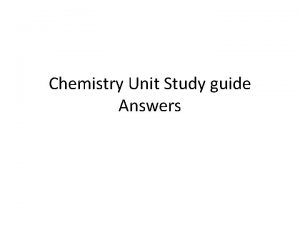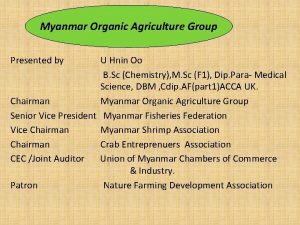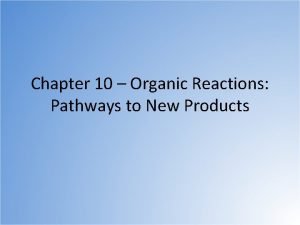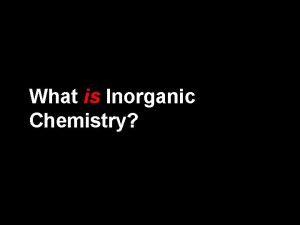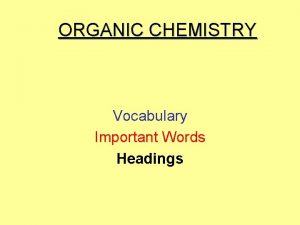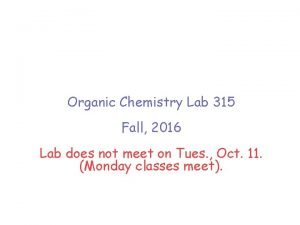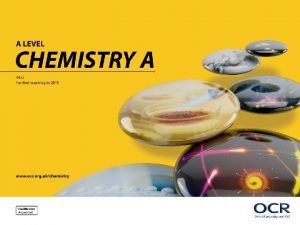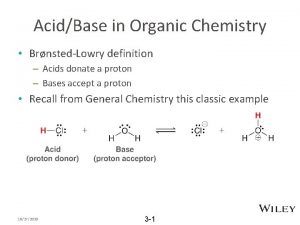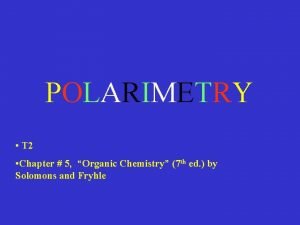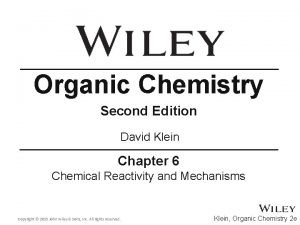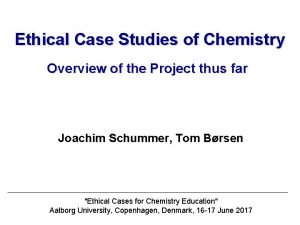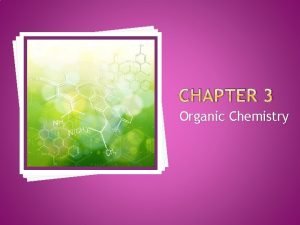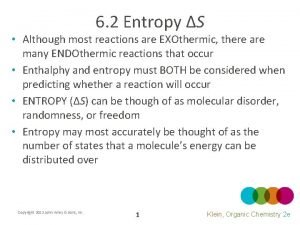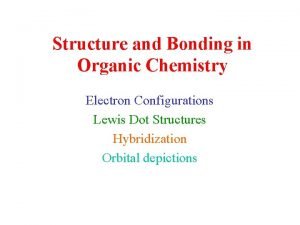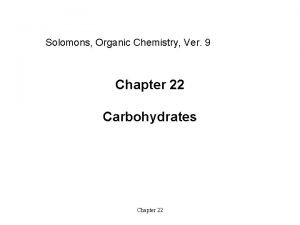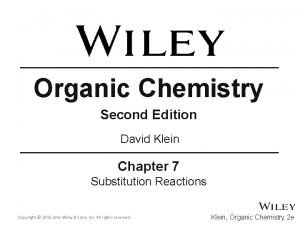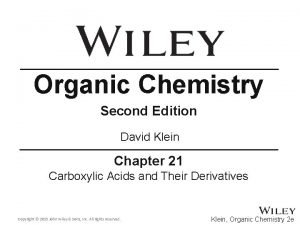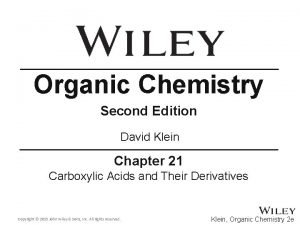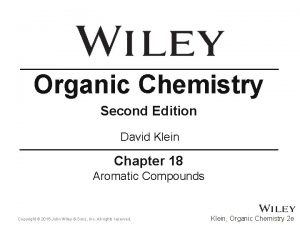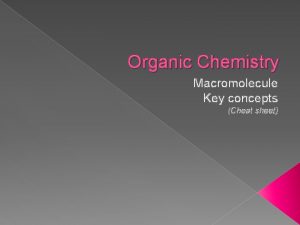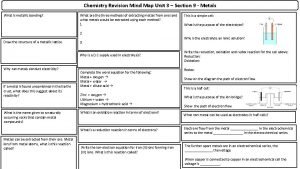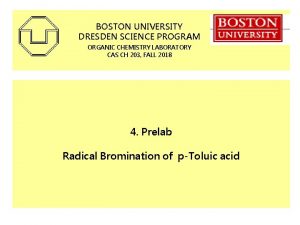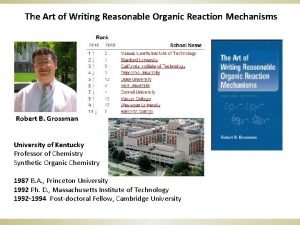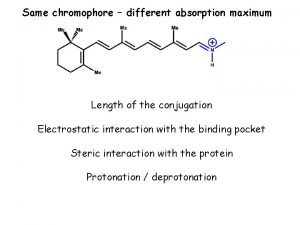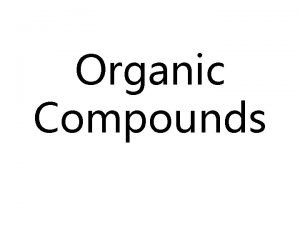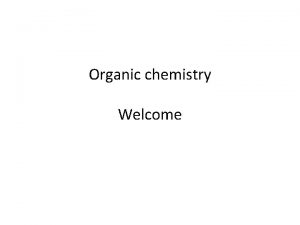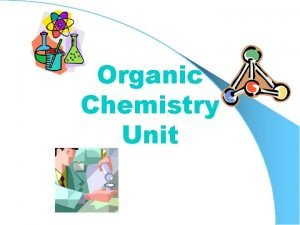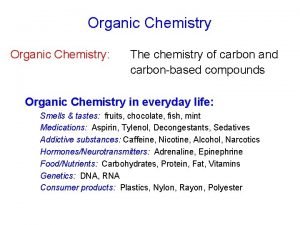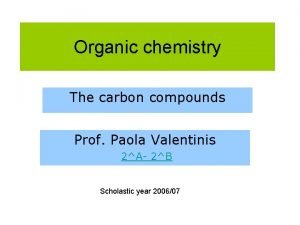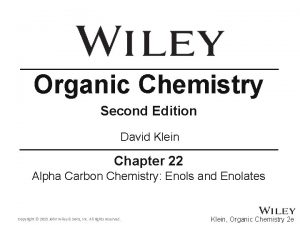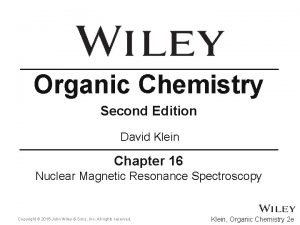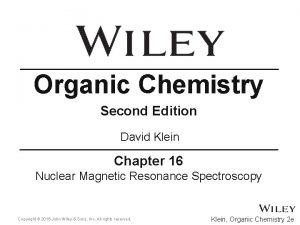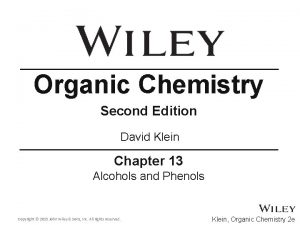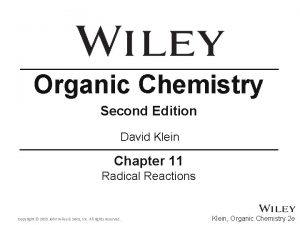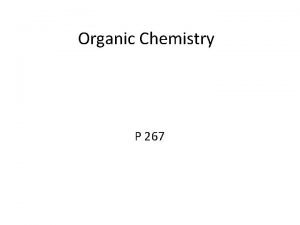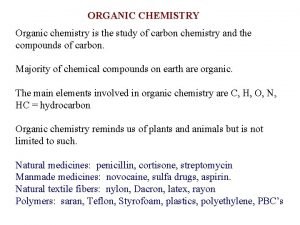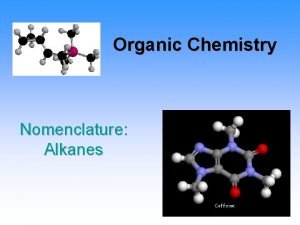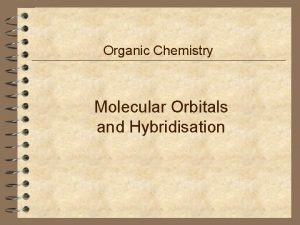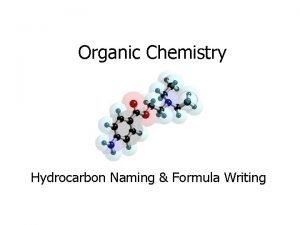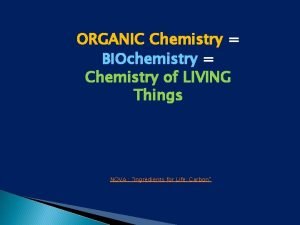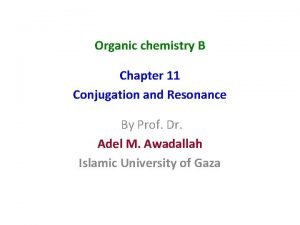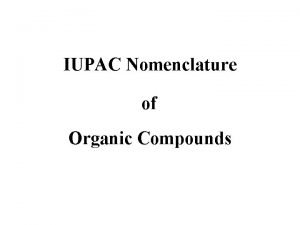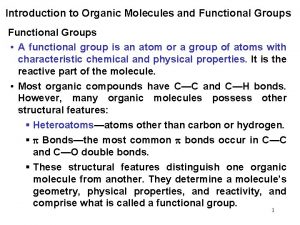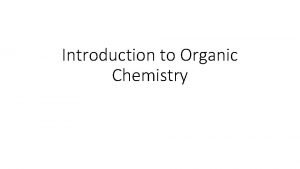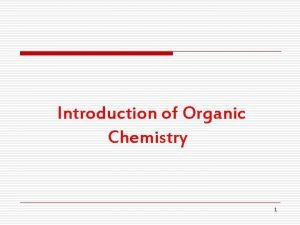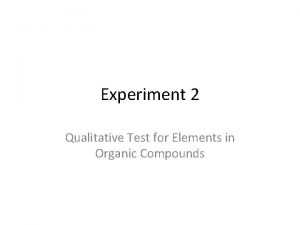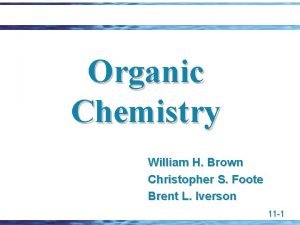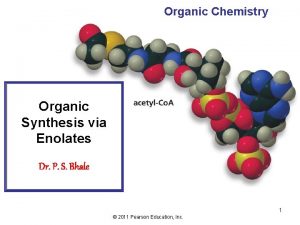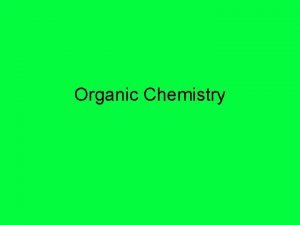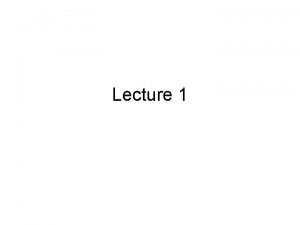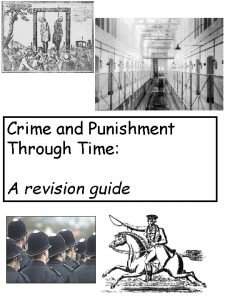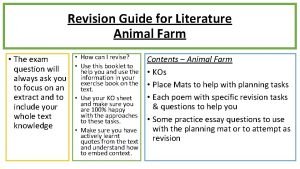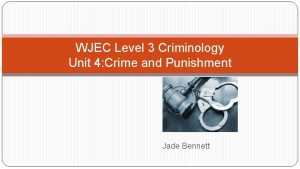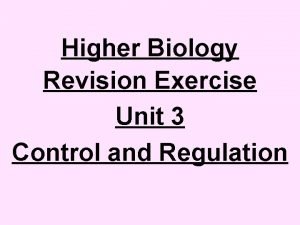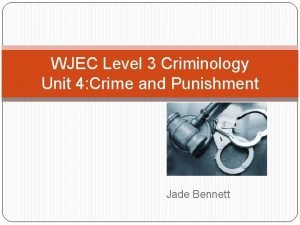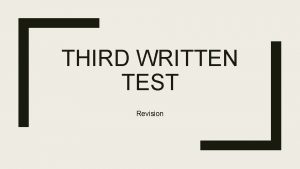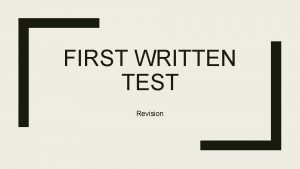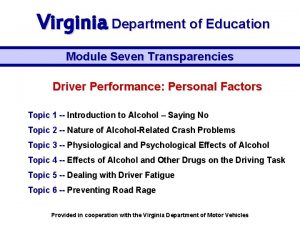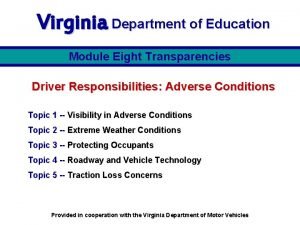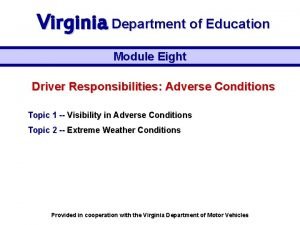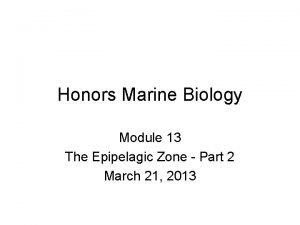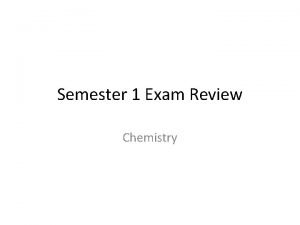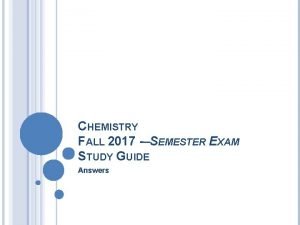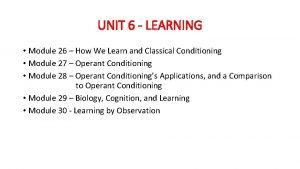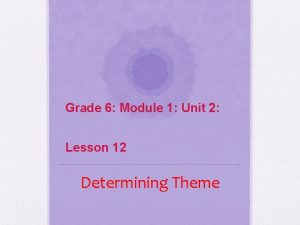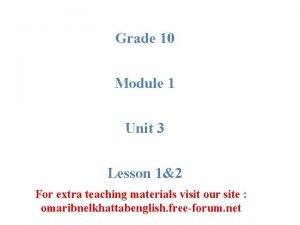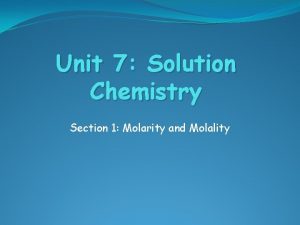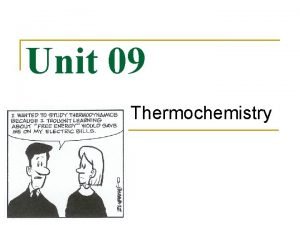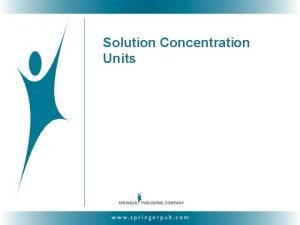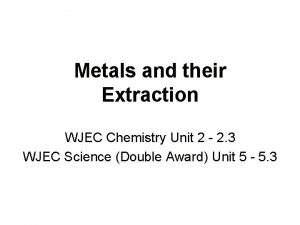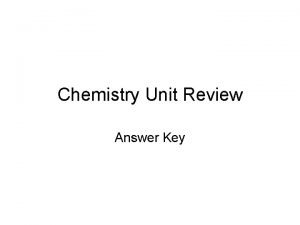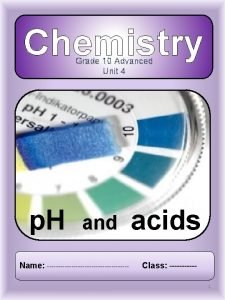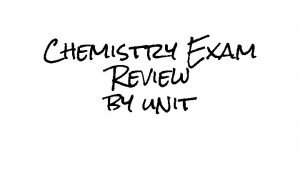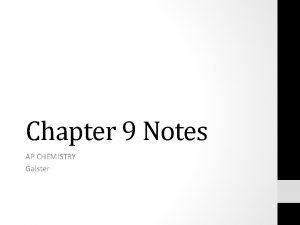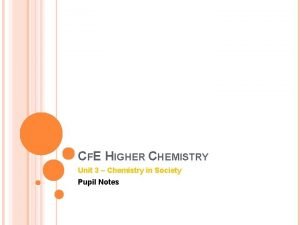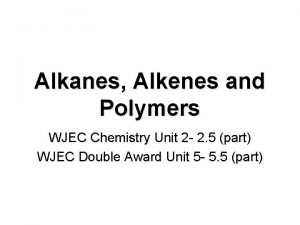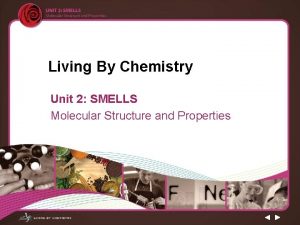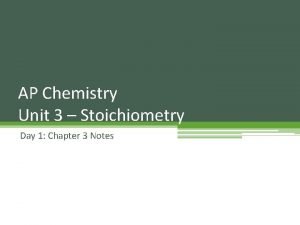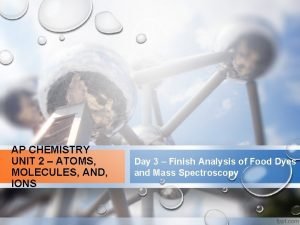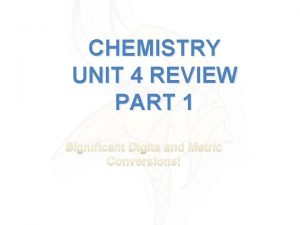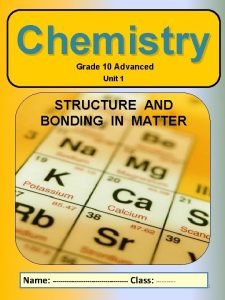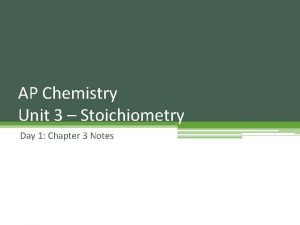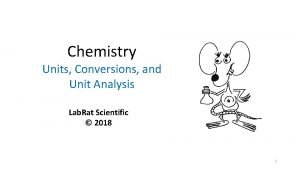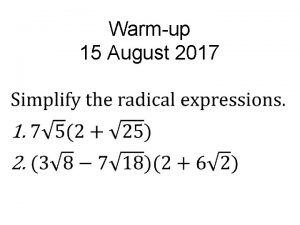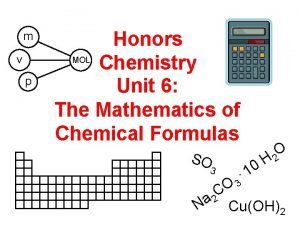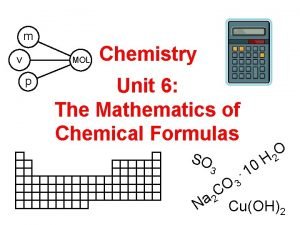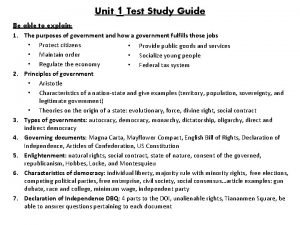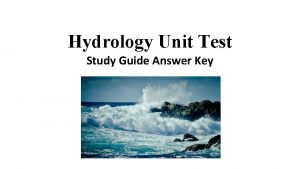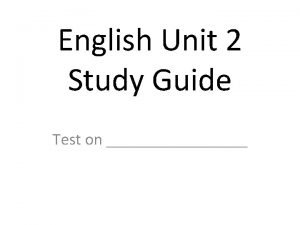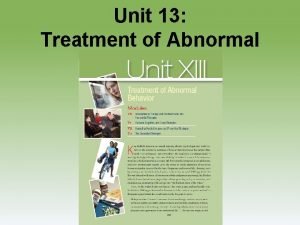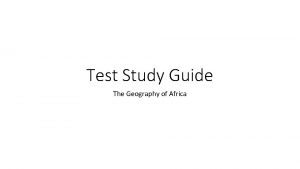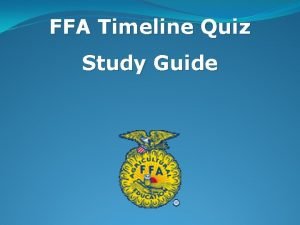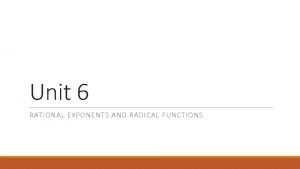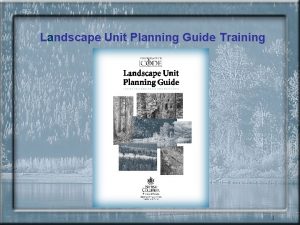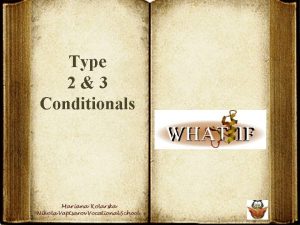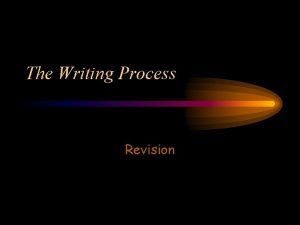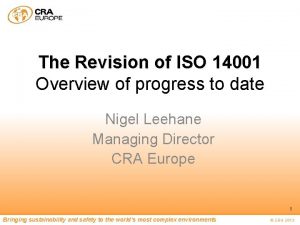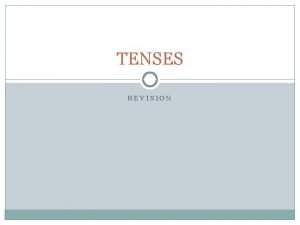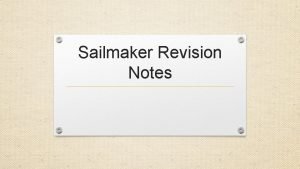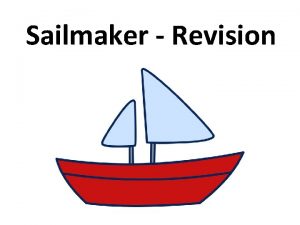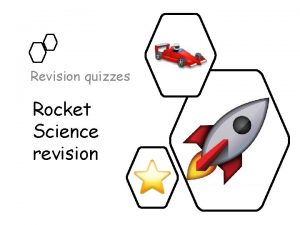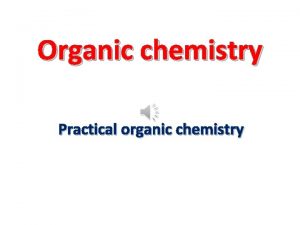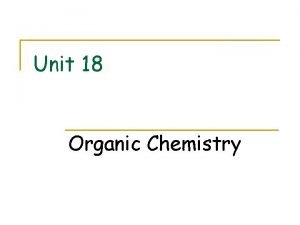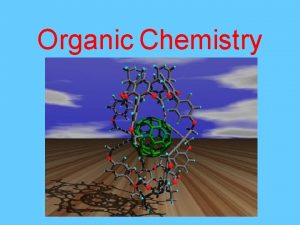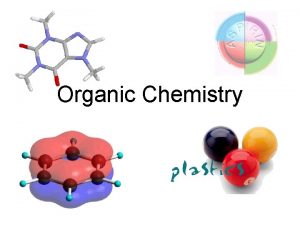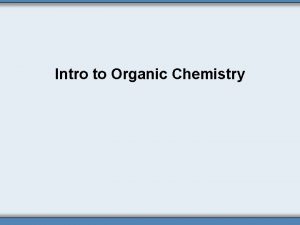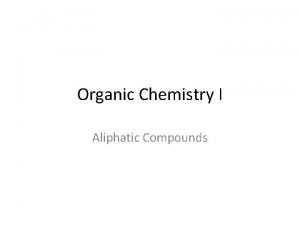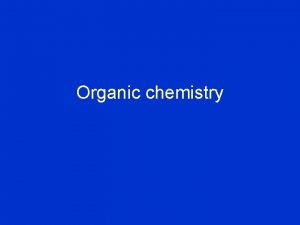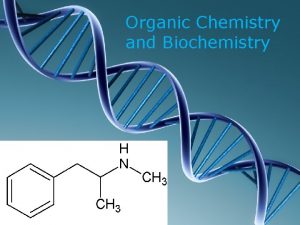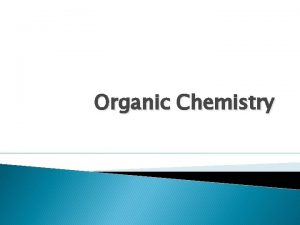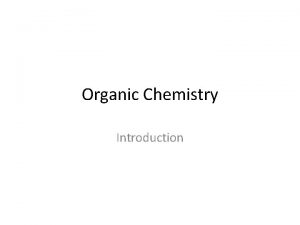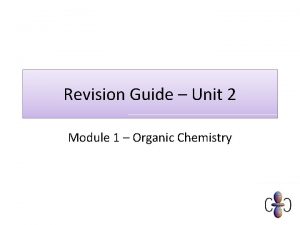Revision Guide Unit 2 Module 1 Organic Chemistry















![Model answers 1. Cn. H 2 n+2 [1] ALLOW Cn. H 2(n+1) IGNORE size Model answers 1. Cn. H 2 n+2 [1] ALLOW Cn. H 2(n+1) IGNORE size](https://slidetodoc.com/presentation_image/31196c66238d29cd9327c62cd0910885/image-16.jpg)










































































































































































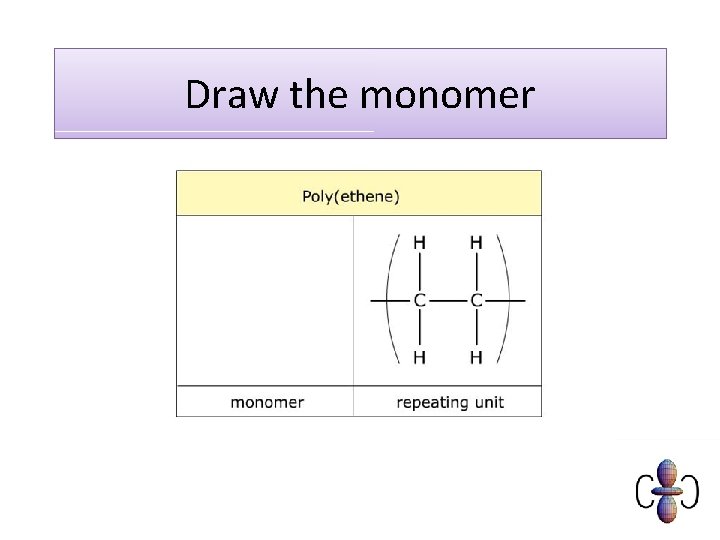
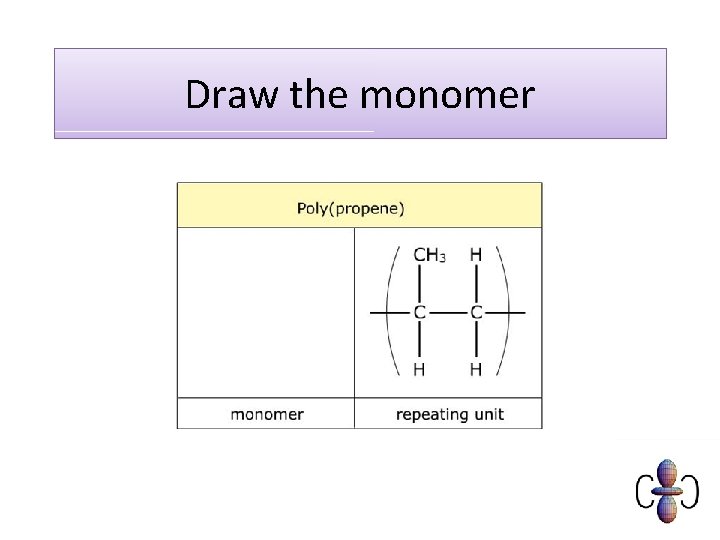
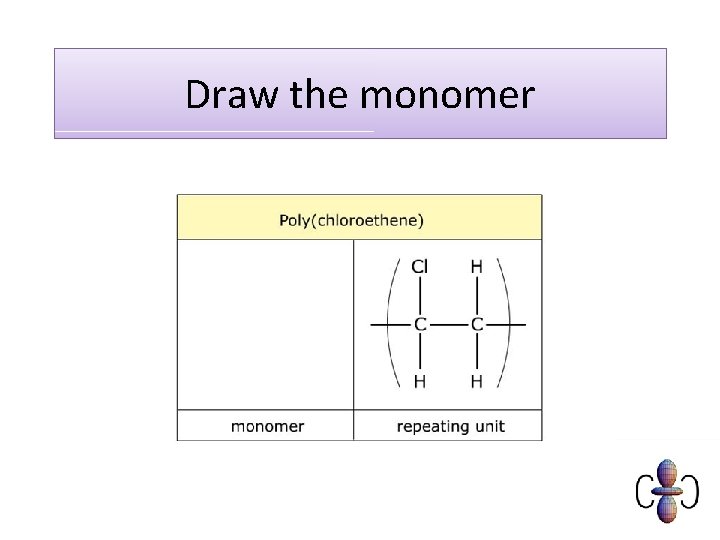
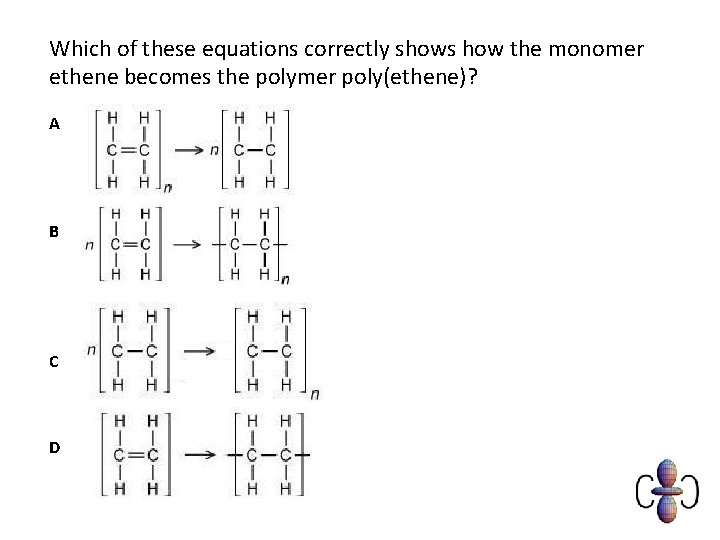
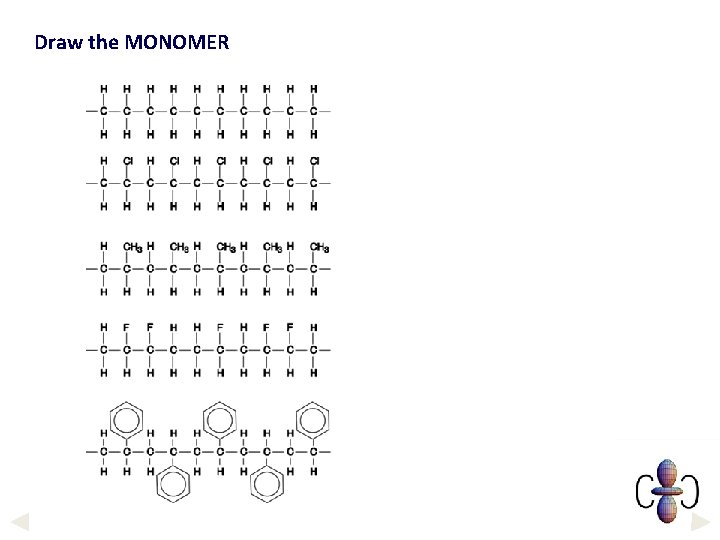
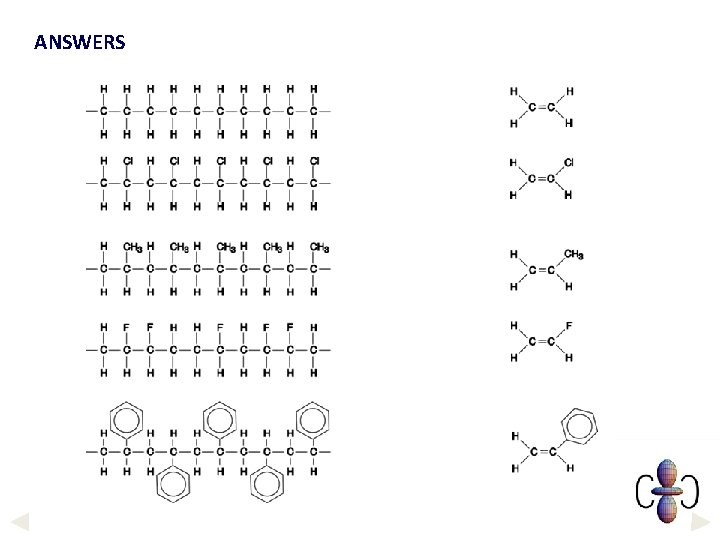
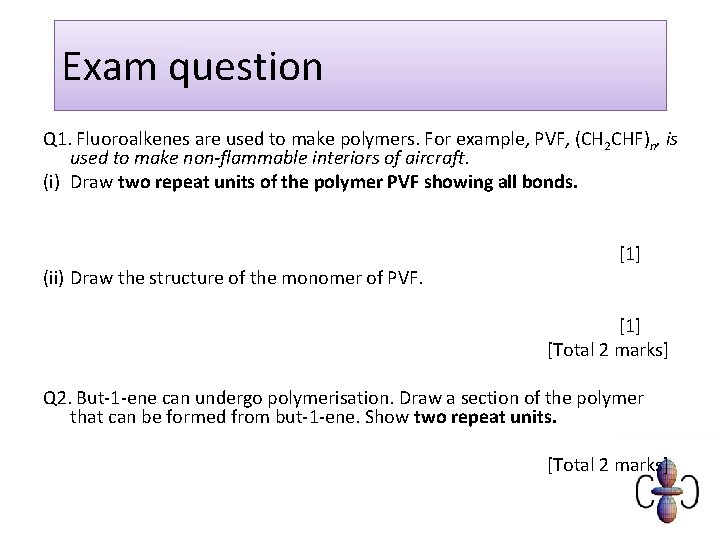
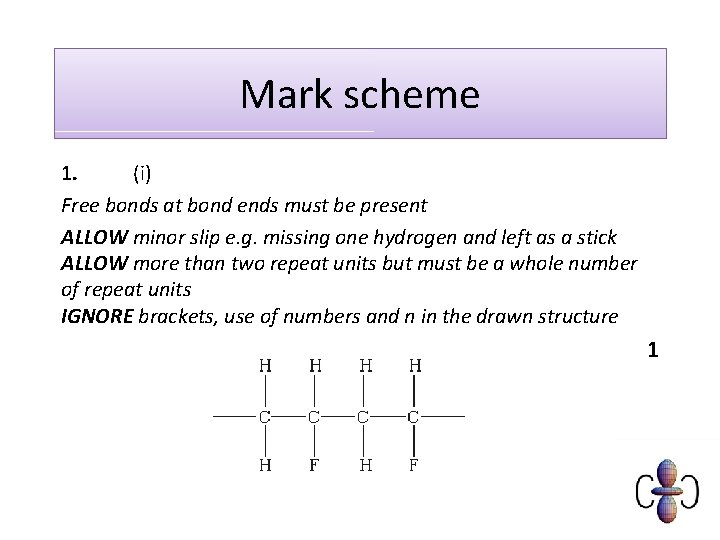
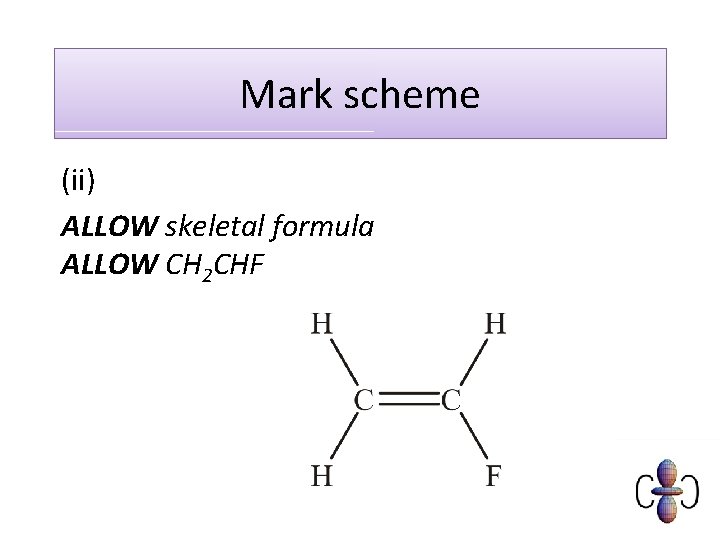
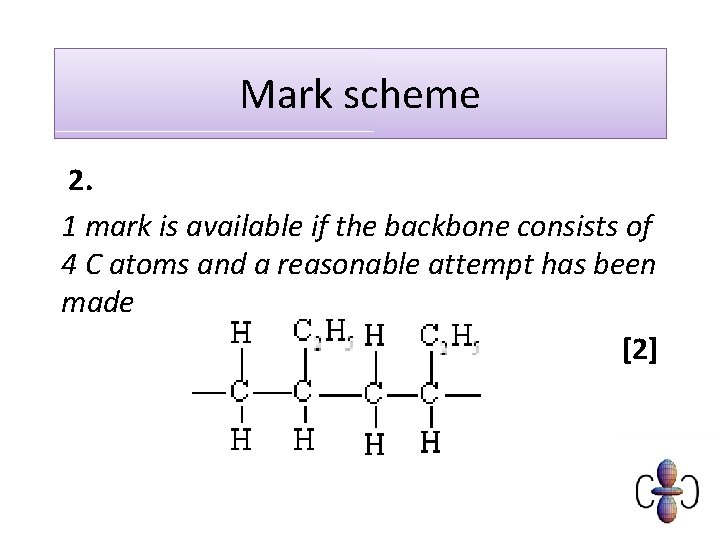
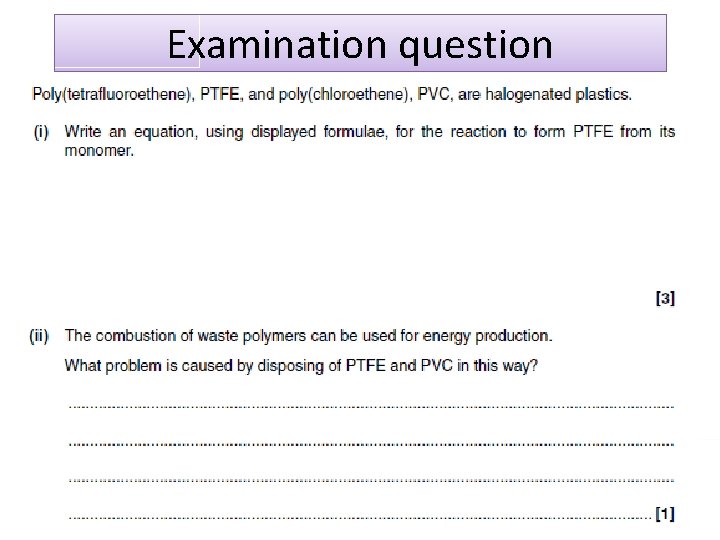
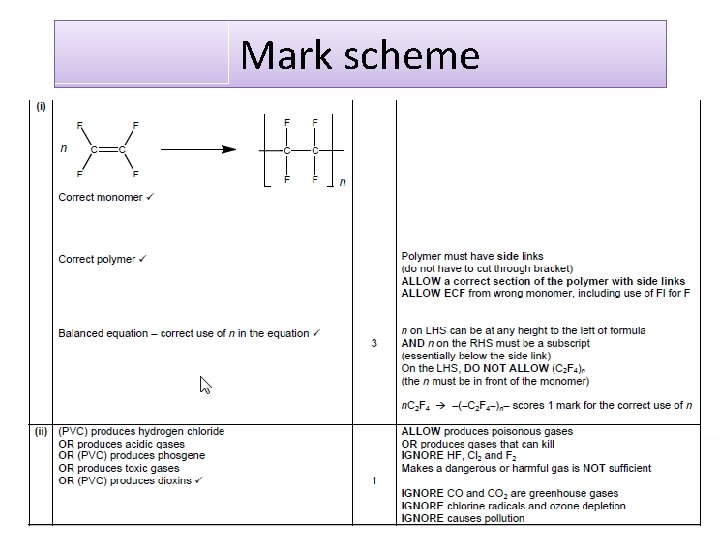
- Slides: 198

Revision Guide – Unit 2 Module 1 – Organic Chemistry

Types of formulae

Types of formula you need to know 1. 2. 3. 4. 5. 6. Empirical Molecular Displayed Structural Skeletal General

Definitions • empirical formula - the simplest whole number ratio of atoms of each element present in a compound edg CH 2 • molecular formula - the actual number of atoms of each element in a molecule, • general formula - the simplest algebraic formula of a member of a homologous series, ie for an alkane: Cn. H 2 n+2, • structural formula as the minimal detail that shows the arrangement of atoms in a molecule • displayed formula as the relative positioning of atoms and the bonds between them, all bonds shown • skeletal formula as the simplified organic formula, shown by removing hydrogen atoms from alkyl chains,

Molecular and empirical formulae There are many ways of representing organic compounds by using different formulae. The molecular formula of a Molecular Empirical compound shows the number of formula each type of atom present in one C 2 H 6 CH 3 molecule of the compound. C 6 H 12 O 6 CH 2 O The empirical formula of a compound shows the simplest C 2 H 4 O 2 CH 2 O ratio of the atoms present. Neither the molecular nor empirical formula gives information about the structure of a molecule.

Exam question

Mark scheme C 6 H 10

Displayed formula of organic compounds The displayed formula of a compound shows the arrangement of atoms in a molecule, as well as all the bonds. Single bonds are represented by a single line, double bonds with two lines and triple bonds by three lines. The displayed formula can show the different structures of compounds with the same molecular formulae. ethanol (C 2 H 6 O) methoxymethane (C 2 H 6 O)

Structural formula of organic compounds The structural formula of a compound shows how the atoms are arranged in a molecule and, in particular, shows which functional groups are present. Unlike displayed formulae, structural formulae do not show single bonds, although double/triple bonds may be shown. CH 3 CHCl. CH 3 H 2 C=CH 2 CH 3 C≡N 2 -chloropropane ethene ethanenitrile

Skeletal formula of organic compounds The skeletal formula of a compound shows the bonds between carbon atoms, but not the atoms themselves. Hydrogen atoms are also omitted, but other atoms are shown.

Examination question

Mark scheme

Definitions homologous series is a series of organic compounds having the same functional group but with each successive member differing by CH 2, functional group is a group of atoms responsible for the characteristic reactions of a compound

You need to know How to use the general formula of a homologous series to predict the formula of any member of the series; How to create the general formula of a homologous series Be able to state the names of the first ten members of the alkanes homologous series;

Exam question Q 1. Crude oil is a source of hydrocarbons which can be used as fuels or for processing into petrochemicals. Octane, C 8 H 18, is one of the alkanes present in petrol. Carbon dioxide is formed during the complete combustion of octane. C 8 H 18 + 12½O 2 → 8 CO 2 + 9 H 2 O What is the general formula for an alkane? . . . . . . . . [Total 1 mark] Q 2. Predict the molecular formula of an alkane with 13 carbon atoms. . . . . . . . [Total 1 mark]
![Model answers 1 Cn H 2 n2 1 ALLOW Cn H 2n1 IGNORE size Model answers 1. Cn. H 2 n+2 [1] ALLOW Cn. H 2(n+1) IGNORE size](https://slidetodoc.com/presentation_image/31196c66238d29cd9327c62cd0910885/image-16.jpg)
Model answers 1. Cn. H 2 n+2 [1] ALLOW Cn. H 2(n+1) IGNORE size of subscripts 2. C 13 H 28 [1]

Examination question

Mark scheme

Examination question

Mark scheme

Examination question

Mark scheme

Functional groups and homologous series A functional group is an atom or group of atoms responsible for the typical chemical reactions of a molecule. A homologous series is a group of molecules with the same functional group but a different number of –CH 2 groups. methanoic acid (HCOOH) ethanoic acid (CH 3 COOH) propanoic acid (CH 3 CH 2 COOH) Functional groups determine the pattern of reactivity of a homologous series, whereas the carbon chain length determines physical properties such as melting/boiling points.

Naming compounds

COMMON FUNCTIONAL GROUPS ALKANE CARBOXYLIC ACID ALKENE ALKYNE ESTER HALOALKANE AMINE NITRILE ACYL CHLORIDE AMIDE ALCOHOL ETHER NITRO ALDEHYDE KETONE SULPHONIC ACID

I. U. P. A. C. NOMENCLATURE A systematic name has STEM – This is the number of carbon atoms in longest chain bearing the functional group PREFIX - This shows the position and identity of any side-chain substituents SUFFIX - This shows the functional group is present Number of C atoms stem name 1 2 3 4 5 6 7 8 9 10 methethpropbutpenthexheptoctnondec-

Common prefixes 1 -methyl 1 -propyl 1 -fluoro dichloro 2 -methyl 2 -propyl 2 -fluoro trichloro 1 -ethyl 1 -chloro 1 -amino 2 -ethyl 2 -chlorofluoro 2 -amino

Common suffixes -ene -yne -oic acid -ol -al -one -oyl chloride -nitrile -amide alkene (double bond) alkyne (triple bond) carboxylic acid alcohol aldehyde ketone acyl chloride nitrile amide

Putting it all together • Start with the stem “propan” • Add the functional group and its position “ 1 -ol” • Add any substituent(s) and their position(s) “ 2 -amino” • 2 -amino propan-1 -ol

Putting it all together • Start with the stem • Add the functional group • Add any substituent(s) and their position(s)

Putting it all together • Start with the stem • “propan” • Add the functional group • “oic acid” • Add any substituent(s) and their position(s) • “ 2 -methyl” • 2 -methyl propanoic acid

Examination questions

Mark scheme

Branching Look at the structures and work out how many carbon atoms are in the longest chain. CH 3 CH 2 CH 3 CH 3 CH 2 CH CH CH 3 CH 2 CH CH 3

Answers CH 3 LONGEST CHAIN = 5 CH 2 CH 3 CH 2 CH CH 3 LONGEST CHAIN = 6 CH 3 CH 2 CH CH CH 3 LONGEST CHAIN = 6

NOMENCLATURE - rules Rules - Summary 1. 2. 3. 4. 5. 6. Number the principal chain from one end to give the lowest numbers. Side-chain names appear in alphabetical order butyl, ethyl, methyl, propyl Each side-chain is given its own number. If identical side-chains appear more than once, prefix with di, tri, tetra, penta, hexa Numbers are separated from names by a HYPHEN e. g. 2 methylheptane Numbers are separated from numbers by a COMMA e. g. 2, 3 dimethylbutane

Test your understanding Apply the rules and name these alkanes CH 3 CH 2 CH 3 CH 2 CH CH 3 CH 2 CH CH CH 3

Answers Apply the rules and name these alkanes Longest chain = 5 - so it is a pentane stem. CH 3, methyl, group is attached to the third carbon from one end. . . 3 -methylpentane CH 3 CH 2 CH 3 CH 2 CH CH 3 CH 2 CH CH CH 3 Longest chain = 6 - so it is a hexane stem. CH 3, methyl, group is attached to the second carbon from one end. . . 2 -methylhexane Longest chain = 6 - so it is a hexane stem, CH 3, methyl, groups are attached to the third and fourth carbon atoms (whichever end you count from), so we use the prefix ‘di’… 3, 4 -dimethylhexane

Examination questions

Mark scheme

Naming Alkenes Suffix -ENE Length In alkenes the principal chain is not always the longest chain It must contain the double bond Position Count from one end as with alkanes. Indicated by the lower numbered carbon atom on one end of the C=C bond 5 4 3 2 1 CH 3 CH 2 CH=CHCH 3 is pent-2 -ene (NOT pent-3 -ene) Side-chain Named similar to alkanes. The position is based on the number allocated to the double bond 1 2 3 4 CH 2 = CH(CH 3)CH 2 CH 3 2 -methylbut-1 -ene 1 2 3 4 CH 2 = CHCH(CH 3)CH 3 3 -methylbut-1 -ene

Exam question Q 1. Draw the skeletal formula for 2 -methylpentan-3 -ol. [Total 1 mark]

Mark scheme

Isomerism

Definitions • structural isomers are compounds with the same molecular formula but different structural formulae, • stereoisomers are compounds with the same structural formula but with a different arrangement in space, • E/Z isomerism is an example of stereoisomerism, arising from restricted rotation about a double bond. Two different groups must be attached to each carbon atom of the C=C group, • cis-trans isomerism are a special case of E/Z isomerism in which two of the substituent groups are the same;

What do I need to be able to do? Determine the possible structural formulae and/or stereoisomers of an organic molecule, given its molecular formula.

TYPES OF ISOMERISM CHAIN ISOMERISM STRUCTURAL ISOMERISM Same molecular formula but different structural formulae POSITION ISOMERISM FUNCTIONAL GROUP ISOMERISM E/Z ISOMERISM STEREOISOMERISM Same molecular formula but atoms occupy different positions in space. Occurs due to the restricted rotation of C=C double bonds. . . two forms… E and Z (CIS and TRANS) OPTICAL ISOMERISM Occurs when molecules have a chiral centre. Get two nonsuperimposable mirror images.

Structural isomerism - chain • These are caused by different arrangements of the carbon skeleton. They have similar chemical properties • These have slightly different physical properties • Make the structural isomers of C 4 H 10. BUTANE - 0. 5°C straight chain 2 -METHYLPROPANE - 11. 7°C branched

Structural isomerism - positional • Each molecule has the same carbon skeleton. • Each molecule has the same functional group. . . BUT the functional group is in a different position • They have similar chemical properties • They have different physical properties 1 2 PENT-1 -ENE double bond between carbons 1 and 2 2 3 PENT-2 -ENE double bond between carbons 2 and 3

Structural isomerism - Functional group • • Molecules have same molecular formula Molecules have different functional groups Molecules have different chemical properties Molecules have different physical properties ALCOHOLS and ETHERS ALDEHYDES and KETONES ACIDS and ESTERS

Examination questions

Mark scheme

Examination question

Mark scheme

Stereoisomerism Molecules have the same molecular formula but the atoms are joined to each other in a different spacial arrangement - they occupy a different position in 3 dimensional space. There are two types. . . • E/Z isomerism • Optical isomerism

E/Z isomerism • These are found in some, but not all, alkenes • These isomers occurs due to the lack of rotation of the carbon-carbon double bond (C=C bonds) Z Groups/atoms are on the SAME SIDE of the double bond E Groups/atoms are on OPPOSITE SIDES across the double bond CIS and TRANS are a special case of E/Z where the groups on each side of the double bond are the same

Examination question

Mark scheme

Examination question

Mark scheme

Examination question

Mark scheme

Optical isomerism These occur when compounds have non-superimposable mirror images The two different forms are known as optical isomers or enantiomers. They occur when molecules have a chiral centre. A chiral centre contains an asymmetric carbon atom. An asymmetric carbon has four different atoms (or groups) arranged tetrahedrally around it.

Chiral centres 1 1 4 4 2 3 There are four different colours arranged tetrahedrally about the carbon atom.

Percentage yield and atom economy

Definitions •

You need to be able to… • explain that addition reactions have an atom economy of 100%, whereas substitution reactions are less efficient • describe the benefits of developing chemical processes with a high atom economy in terms of fewer waste materials • explain that a reaction may have a high percentage yield but a low atom economy

Percentage yield calculations 1. When calcium carbonate is heated fiercely it decomposes to form calcium oxide and carbon dioxide. Ca. CO 3(s) Ca. O(s) + CO 2(g) 5. 00 g of calcium carbonate produced 2. 50 g of calcium oxide. What is the percentage yield of this reaction? 2. Potassium chloride is made by the reaction between potassium and chlorine. 2 K(s) + Cl 2(g) 2 KCl(s) 4. 00 g of potassium produced 7. 20 g of potassium chloride. What is the percentage yield of this reaction? 3. When potassium chlorate is heated strongly it decomposes to produce potassium chloride and oxygen. 2 KCl. O 3(s) 2 KCl(s) + 3 O 2(g) Heating 3. 00 g of potassium chlorate produced 1. 60 g of potassium chloride. What is the percentage yield of this reaction?

Test your knowledge - answers 1. When calcium carbonate is heated fiercely it decomposes to form calcium oxide and carbon dioxide. Ca. CO 3(s) Ca. O(s) + CO 2(g) 5. 00 g of calcium carbonate produced 2. 50 g of calcium oxide. What is the percentage yield of this reaction? 89. 3% 2. Potassium chloride is made by the reaction between potassium and chlorine. 2 K(s) + Cl 2(g) 2 KCl(s) 4. 00 g of potassium produced 7. 20 g of potassium chloride. What is the percentage yield of this reaction? 94. 2% 3. When potassium chlorate is heated strongly it decomposes to produce potassium chloride and oxygen. 2 KCl. O 3(s) 2 KCl(s) + 3 O 2(g) Heating 3. 00 g of potassium chlorate produced 1. 60 g of potassium chloride. What is the percentage yield of this reaction? 87. 9%

Atom economy • In most reactions you only want to make one of the resulting products • Atom economy is a measure of how much of the products are useful • A high atom economy means that there is less waste this means the process is MORE SUSTAINABLE.

Atom economy calculations Calculate the atom economy for the formation of nitrobenzene, C 6 H 5 NO 2 Equation Mr C 6 H 6 + HNO 3 78 63 C 6 H 5 NO 2 123 Atom economy = molecular mass of C 6 H 5 NO 2 + H 2 O 18 x 100 molecular mass of all products = 123 + 18 x 100 = 87. 2% An ATOM ECONOMY of 100% is not possible with a SUBSTITUTION REACTION like this

Atom economy - calculations Calculate the atom economy for the preparation of ammonia from thermal decomposition of ammonium sulphate. Equation Mr Atom economy (NH 4)2 SO 4 132 H 2 SO 4 98 + = 2 x molecular mass of NH 3 2 NH 3 17 x 100 molecular mass of all products = 2 x 17 = 25. 8% 98 + (2 x 17) In industry a low ATOM ECONOMY isn’t necessarily that bad if you can use some of the other products. If this reaction was used industrially, which it isn’t, the sulphuric acid would be a very useful by-product.

Examination question



Mark scheme


Examination question




Mark scheme



Crude oil

Definitions • A hydrocarbon is a compound of hydrogen and carbon only • Crude oil is a source of hydrocarbons, separated as fractions with different boiling points by fractional distillation, which can be used as fuels or for processing into petrochemicals • Alkanes and cycloalkanes are saturated hydrocarbons which have only single bonds between carbon atoms. Unsaturated carbon atoms have at least one carbon double bond. • There is a tetrahedral shape around each carbon atom in alkanes (this is called sp 3 hybridised).

You need to be able to… • Explain, in terms of Van der Waals’ forces, the variations in the boiling points of alkanes with different carbon-chain length and branching; • Describe the complete combustion of alkanes, leading to their use as fuels in industry, in the home and in transport • Explain, using equations, the incomplete combustion of alkanes in a limited supply of oxygen and outline the potential dangers arising from production of CO in the home and from car use

Shapes of carbon compounds In alkanes, bonds from carbon atoms are arranged tetrahedrally. Carbon - has four outer electrons, therefore forms four covalent bonds H H C H H BOND PAIRS 4 BOND ANGLE. . . 109. 5° SHAPE. . . TETRAHEDRAL

Examination questions

Mark scheme

Crude oil and alkanes Crude oil is a mixture composed mainly of straight and branched chain alkanes. It also includes lesser amounts of cycloalkanes and arenes, both of which are hydrocarbons containing a ring of carbon atoms, as well as impurities such as sulfur compounds. The exact composition of crude oil depends on the conditions under which it formed, so crude oil extracted at different locations has different compositions.


Key points for exam questions To explain fractional distillation 1. Heat crude oil to make it a gas/vapour it rises up the column. 2. Lighter hydrocarbons travel further up the column. 3. Hydrocarbons condense at different temperatures (boiling points). 4. The higher the molecular weight the higher its boiling point (due to stronger Van der Waal’s forces).

Exam question Kerosene is used as a fuel for aeroplane engines. Kerosene is obtained from crude oil. Name the process used to obtain kerosene from crude oil and explain why the process works. . . . . . . . . . . . . . . . . [Total 2 marks]

Mark scheme Fractional distillation DO NOT ALLOW just ‘distillation’ Because fractions have different boiling points For fractions, ALLOW components OR hydrocarbons OR compounds ALLOW condense at different temperatures ALLOW because van der Waals’ forces differ between molecules IGNORE reference to melting points IGNORE ‘crude oil’ OR ‘mixture’ has different boiling points’ ……… but ALLOW ‘separates crude oil by boiling points [2]

Examination question

Mark scheme

Shapes of molecules and Van der Waals forces C C C C Greater contact between linear butane molecules STRONGER Van der Waal forces HIGHER boiling point C C C WEAKER Van der Waal forces C C Less contact between branched methylpropane molecules C LOWER boiling point

Summary - trends in boiling points The boiling point of straight-chain alkanes increases with chain length. Branched-chain alkanes have lower boiling points.

Combustion • Complete combustion occurs when there is enough oxygen – for example when the hole is open on a Bunsen burner. • The products of complete combustion are carbon dioxide and water. CH 4 + 2 O 2 CO 2 + 2 H 2 O

Af. L - Complete combustion

Incomplete combustion • Incomplete combustion occurs when there is not enough oxygen – for example when the hole is closed on a Bunsen burner. • The products of incomplete combustion include carbon monoxide and carbon (soot). It is often called a sooty flame. • This is the equation for the incomplete combustion of propane • 2 C 3 H 8 + 7 O 2 2 C + 2 CO 2 + 8 H 2 O

Af. L – incomplete combustion

Problems arising from burning fuels • There a number of key pollutants arising from burning fossil fuels

Carbon dioxide • Carbon dioxide is a greenhouse gas. • This means it causes by absorbing infrared radiation from the surface of the Earth trapping heat from the sun within the Earth’s atmosphere.

Carbon monoxide • Carbon monoxide is an odourless and tasteless . • It is formed due to the incomplete combustion of hydrocarbons from crude oil such as petrol or diesel or domestic gas. • If produced in an enclosed space it can be deadly.

Soot/smoke particles • Particles of carbon from incomplete combustion can be released into the atmosphere. • This contributes to

Other pollutants • Sulphur present in fuels burns to produce sulphur dioxide. • At high temperatures oxides of nitrogen may also be formed from nitrogen in the atmosphere. • These react with water in the atmosphere to form

Acid rain

Cleaning up • Undesirable combustion products can be cleaned from emissions before they leave the chimney by using a filter or catalytic converter (cars).

Sustainability Contrast the value of fossil fuels for providing energy and raw materials with; (i) the problem of an over-reliance on nonrenewable fossil fuel reserves and the importance of developing renewable plant based fuels, ie alcohols and biodiesel (ii) increased CO 2 levels from combustion of fossil fuels leading to global warming and climate change

Biofuels

The problem with crude • Crude oil is a limited resource that will eventually run out. • Alternatives are needed and some are already under development.

Ethical and environmental issues • Clearance of rainforests to plant fuel crops • Using land formerly used for food crop (causing hardship) • Not replacing crops with sufficient crops after harvest for the process to remain carbon neutral • Erosion – replacing trees with crops with shallow roots

Carbon neutral • Plants photosynthesise using carbon (dioxide) from the air • Biodiesel/bioethanol releases carbon (dioxide) from plants • Plants are replanted and photosynthesise, removing the carbon (dioxide) again. • (fossil) diesel from crude oil releases ‘locked up’ carbon (dioxide) and doesn’t absorb any CO 2

Carbon neutral… or not? • Energy needed for processing biofuels and transporting is not offset by photosynthesis so is not completely carbon neutral.

Examination question

Mark scheme

Examination question

Mark scheme

Different types of biofuels • Ethanol – produced by fermentation of sugars in sugarcane • Biodiesel – produced from hydrolysis of vegetable oils

How do we make ethanol? • Fermentation is a key process for obtaining ethanol. It is relatively cheap and requires wheat or beet sugar. • The process involves the anaerobic respiration of yeast at temperatures between 20 and 40°C and at p. H 7. 122

Conditions for fermentation • Outside an optimum temperature the yeast does not work (high temperatures kill the yeast). • Outside an optimum p. H the yeast does not work (extremes of p. H kill the yeast). • To make ethanol the yeast must respire anaerobically (without oxygen). • Eventually the ethanol concentration will be too high for the fermentation to continue. This means only a dilute solution can be made. 123

Example question 124

Mark scheme 125

Example question 126

Mark scheme 127

Example question 128

Mark scheme 129

How do we obtain a concentrated solution? • Ethanol has a different boiling point to water. We can therefore separate water and ethanol using distillation. 130

Example question 131

Mark scheme 132

Examination question

Mark scheme

Examination question

Examination question

Mark scheme

Catalytic Cracking

You need to be able to: Describe the use of catalytic cracking to obtain more useful alkanes and alkenes; Explain that the petroleum industry processes straight-chain hydrocarbons into branched alkanes and cyclic hydrocarbons to promote efficient combustion and prevent ‘knocking’;

Examination question

Mark scheme Tip: This answer on more efficient combustion (reduced knocking) is useful for branched chains too

What is cracking? Cracking is a process that splits long chain alkanes into shorter chain alkanes, alkenes and hydrogen. C 10 H 22 → C 7 H 16 + C 3 H 6 Cracking has the following uses: l it increases the amount of gasoline and other economically important fractions l it increases branching in chains, an important factor improving combustion in petrol l it produces alkenes, an important feedstock for chemicals. There are two main types of cracking: thermal and catalytic.

Heat the hydrocarbons to vaporise Pass over a hot zeolite catalyst OR Heat to high temperature and pressure Decomposition then occurs Shorter alkenes and branched / cyclic alkanes formed

Cracking (a) Thermal Cracking (b) Catalytic Cracking Large alkane mols treated at 700 – 1200 K and 7000 k. Pa for 0. 5 seconds Large alkane mols treated at » 700 K and slight pressure using a ZEOLITE CATALYST (= Al 2 O 3 + Si. O 2) Produces high % of alkenes, + some smaller alkane mols, + some H 2(g) Alkenes = raw materials for polymers etc Produces branched alkanes + cyclohexane (C 6 H 12) + benzene (C 6 H 6) + some H 2(g) Branched alkanes = more efficient fuels Benzene = raw material for plastics, drugs, dyes, explosives etc

Thermal vs. catalytic cracking List the advantages catalytic cracking has over thermal cracking: l it produces a higher proportion of branched alkanes, which burn more easily than straight-chain alkanes and are therefore an important component of petrol l the use of a lower temperature and pressure mean it is cheaper l it produces a higher proportion of arenes, which are valuable feedstock chemicals. However, unlike thermal cracking, catalytic cracking cannot be used on all fractions, such as bitumen, the supply of which outstrips its demand.

Radicals

Definitions Radical - a species with an unpaired electron Homolytic fission is where two radicals are formed when a bond splits evenly and each atom gets one of the two electrons. Heterolytic fission is where both electrons from a bond go to one of the atoms to form a cation and an anion; A ‘curly arrow’ represents the movement of an electron pair, showing either breaking or formation of a covalent bond;

You need to be able to… • Outline reaction mechanisms, using diagrams, to show clearly the movement of an electron pair with ‘curly arrows’; • Describe the substitution of alkanes using ultraviolet radiation, by Cl 2 and by Br 2, to form halogenoalkanes; • Describe how homolytic fission leads to the mechanism of radical substitution in alkanes in terms of initiation, propagation and termination reactions (see also 2. 1. 1. h); • Explain the limitations of radical substitution in synthesis, arising from further substitution with formation of a mixture of products.

Chlorination of methane Initiation During initiation the Cl-Cl bond is broken in preference to the others as it is requires less energy to separate the atoms. Cl 2 2 Cl • radicals created – the single dots represent unpaired electrons Propagation Free radicals are very reactive because they want to pair up their single electron. Cl • + CH 4 CH 3 • + HCl Cl 2 + CH 3 • CH 3 Cl + Cl • radicals used are regenerated ‘propagating’ the reaction Termination Cl • + CH 3 • CH 3 Cl Cl • + Cl • Cl 2 CH 3 • + CH 3 • C 2 H 6 As two radicals react together they are removed This is unlikely at the start because of their low concentration

Free radicals - summary • reactive species (atoms or groups) which possess an unpaired electron • They react in order to pair up the single electron • formed by homolytic fission of covalent bonds • formed during the reaction between chlorine and methane (UV) • formed during thermal cracking • involved in the reactions taking place in the ozone layer

Other products of chain reactions If an alkane is more than two carbons in length then any of the hydrogen atoms may be substituted, leading to a mixture of different isomers. For example: 1 -chloropropane 2 -chloropropane The mixture of products is difficult to separate, and this is one reason why chain reactions are not a good method of preparing halogenoalkanes.

Further substitution in chain reactions Further substitution can occur until all hydrogens are substituted. The further substituted chloroalkanes are impurities that must be removed. The amount of these molecules can be decreased by reducing the proportion of chlorine in the reaction mixture. It is another reason why this method of preparing chloroalkanes is unreliable. Different products can be separated by fractional distillation

Examination question

Mark scheme

Exam question Cyclohexane, C H , reacts with chlorine to produce chlorocyclohexane, C H Cl. C H + Cl C H Cl + HCl The mechanism for this reaction is a free radical substitution. (i) Write an equation to show the initiation step. 6 6 12 12 2 6 6 11 11 . . . . . . . [1] (ii) State the conditions necessary for the initiation step. . . . . . . . [1] (iii)The reaction continues by two propagation steps resulting in the formation of chlorocyclohexane, C H Cl. 6 11 Write equations for these two propagation steps. step 1. . . . . . . step 2. . . . . . . [2] (iv)State what happens to the free radicals in the termination steps. . . . . . . . [1] [Total 5 marks]

Mark scheme (i) Cl 2 2 Cl· (ii)uv (light)/high temperature/min of 400 o. C/ sunlight (iii) Cl· + C 6 H 12 C 6 H 11· + HCl C 6 H 11· + Cl 2 C 6 H 11 Cl + Cl· (iv) react with each other/suitable equation

Alkenes and addition reactions

Definitions • Alkenes and cycloalkenes are unsaturated hydrocarbons; • The double bond is formed from overlap of adjacent porbitals to form a π bond. • There is a trigonal planar shape around each carbon in the C=C of alkenes (this is called sp 2 hybridised) • An electrophile is an electron pair acceptor

You need to be able to… Describe, including mechanism, addition reactions of alkenes, i. hydrogen in the presence of a suitable catalyst, ie Ni, to form alkanes, ii. halogens to form dihalogenoalkanes, including the use of bromine to detect the presence of a double C=C bond as a test for unsaturation, iii. hydrogen halides to form halogenoalkanes, iv. steam in the presence of an acid catalyst to form alcohols

• The bond angle around C=C is 120 degrees due to the overlap of the p-orbitals. • The shape is described as trigonal planar. • The π bond is weaker than a σ bond so the bond energy is less than twice a single bond.


Mark scheme

Examination question

Mark scheme

Hydrogenation Hydrogen can be added to the carbon–carbon double bond in a process called hydrogenation. C 2 H 4 + H 2 C 2 H 6 • Nickel catalyst, • Temperature 200 °C • Pressure 1000 k. Pa. Vegetable oils are unsaturated and may be hydrogenated to make margarine.

Examination question

Mark scheme

Double bonds and electrophiles The double bond of an alkene is an area of high electron density, and therefore an area of high negative charge. The negative charge of the double bond may be attacked by electron-deficient species, which will accept a lone pair of electrons. These species have either a full positive charge or slight positive charge on one or more of their atoms. They are called electrophiles, meaning ‘electron loving’. An electrophile is an electron pair acceptor. Alkenes undergo addition reactions when attacked by electrophiles. This is called electrophilic addition.

Electrophilic Addition Mechanism In this step, a pair of electrons from the double bond forms a co-ordinate covalent bond with A. The A—B bond breaks to release anion B. Notice that a positively charged intermediate, carbocation is formed in this step. In the final step, a lone pair of electrons in B ion forms a co-ordinate covalent bond with the positively charged intermediate.

Examiners’ tips The complete reaction mechanism, with ticks to show the features an examiner is likely to look for in an examination. Make sure the curly arrow starts touching a bond and ends where the electrons will be (a bond or atom).

Examination question


Test for Alkenes • Alkenes DECOLORISE bromine water. • When you add bromine water to an alkene it turns colourless.

Test for alkenes

Reaction with alkenes and bromine A simple equation for the bromine water test with ethene is: CH 2=CH 2 + Br 2 + H 2 O CH 2 Br + H 2 O However, because water is present in such a large amount, a water molecule (which has a lone pair) adds to one of the carbon atoms, followed by the loss of a H+ ion. CH 2=CH 2 + Br 2 + H 2 O CH 2 Br. CH 2 OH + HBr The major product of the test is not 1, 2 -dibromoethane (CH 2 Br) but 2 -bromoethan-1 -ol (CH 2 Br. CH 2 OH).

Past paper questions

Mark scheme

Steam hydrogenation of ethene to make ethanol React with steam at 320 o. C. Phosphoric acid (conc. ) (H 3 PO 4) catalyst

Addition to unsymmetrical alkenes + HBr minor product: 1 -bromopropane major product: 2 -bromopropane Unequal amounts of each product are formed due to the relative stabilities of the carbocation intermediates.

Stability of carbocations The stability of carbocations increases as the number of alkyl groups on the positively-charged carbon atom increases. primary secondary tertiary increasing stability The stability increases because alkyl groups contain a greater electron density than hydrogen atoms. This density is attracted towards, and reduces, the positive charge on the carbon atom, which has a stabilizing effect.

Polymerisation

You need to be able to… • Describe the addition polymerisation of alkenes; • Deduce the repeat unit of an addition polymer obtained from a given monomer; • Identify the monomer that would produce a given section of an addition polymer; • Outline the use of alkenes in the industrial production of organic compounds: – the manufacture of margarine by catalytic hydrogenation of unsaturated vegetable oils using hydrogen and a nickel catalyst, – the formation of a range of polymers using unsaturated monomer units based on the ethene molecule, ie H 2 C=CHCl, F 2 C=CF 2

Addition polymers are named after the monomer used to make them: is prepared from poly(ethene) ethene is prepared from poly(propenenitrile) propenenitrile

Addition polymerisation Free radical process involve high pressure, high temperature and a catalyst. The catalyst is usually a substance (e. g. an organic peroxide) which readily breaks up to form radicals which initiate a chain reaction. Another catalyst is a Ziegler-Natta catalyst (named after the scientists who developed it). Such catalysts are based on the compound Ti. Cl 4.

initiation stage propagation stage termination stage

EXAMPLES OF ADDITION POLYMERISATION ETHENE PROPENE CHLOROETHENE POLY(ETHENE) POLY(PROPENE) POLY(CHLOROETHENE) POLYVINYLCHLORIDE PVC TETRAFLUOROETHENE POLY(TETRAFLUOROETHENE) PTFE “Teflon”

Draw the monomer

Draw the monomer

Draw the monomer

Which of these equations correctly shows how the monomer ethene becomes the polymer poly(ethene)? A B C D

Draw the MONOMER

ANSWERS

Exam question Q 1. Fluoroalkenes are used to make polymers. For example, PVF, (CH 2 CHF)n, is used to make non-flammable interiors of aircraft. (i) Draw two repeat units of the polymer PVF showing all bonds. (ii) Draw the structure of the monomer of PVF. [1] [Total 2 marks] Q 2. But-1 -ene can undergo polymerisation. Draw a section of the polymer that can be formed from but-1 -ene. Show two repeat units. [Total 2 marks]

Mark scheme 1. (i) Free bonds at bond ends must be present ALLOW minor slip e. g. missing one hydrogen and left as a stick ALLOW more than two repeat units but must be a whole number of repeat units IGNORE brackets, use of numbers and n in the drawn structure 1

Mark scheme (ii) ALLOW skeletal formula ALLOW CH 2 CHF

Mark scheme 2. 1 mark is available if the backbone consists of 4 C atoms and a reasonable attempt has been made [2]

Examination question

Mark scheme
 Ib organic chemistry
Ib organic chemistry Inorganic chemistry vs organic chemistry
Inorganic chemistry vs organic chemistry Passive voice revision
Passive voice revision Chemistry unit 3 study guide
Chemistry unit 3 study guide Revision module 1
Revision module 1 Cycloalkanes
Cycloalkanes Canola oil
Canola oil Ester organic chemistry
Ester organic chemistry C10h22oh
C10h22oh Rearranged most stable carbocation is
Rearranged most stable carbocation is Ee organic chemistry
Ee organic chemistry Leveling effect organic chemistry
Leveling effect organic chemistry Organic chemistry (3rd) edition chapter 1 problem 16s
Organic chemistry (3rd) edition chapter 1 problem 16s David klein organic chemistry
David klein organic chemistry Is alkane an organic compound
Is alkane an organic compound Ario practice problems
Ario practice problems Oxo functional group
Oxo functional group Objective lab report example
Objective lab report example Alkane organic chemistry
Alkane organic chemistry Grade 10 organic chemistry
Grade 10 organic chemistry Cyclo organic chemistry
Cyclo organic chemistry Importance of organic compounds
Importance of organic compounds Kiliani fischer synthesis
Kiliani fischer synthesis Crash course organic chemistry
Crash course organic chemistry Alkane cracking
Alkane cracking Met et prop but pent hex hept oct non dec undec
Met et prop but pent hex hept oct non dec undec Organic chemistry myanmar
Organic chemistry myanmar Br2aq
Br2aq Mass spec of chlorine
Mass spec of chlorine Hono organic chemistry
Hono organic chemistry Geminal and vicinal
Geminal and vicinal Organic chemistry topic 11
Organic chemistry topic 11 Chapter 22 review organic chemistry section 1 answers
Chapter 22 review organic chemistry section 1 answers Organic chemistry reaction pathways
Organic chemistry reaction pathways Organic chemistry nomenclature
Organic chemistry nomenclature What is organic chemistry like
What is organic chemistry like Is ch4o organic or inorganic
Is ch4o organic or inorganic Organic chemistry vocabulary
Organic chemistry vocabulary Organic chemistry (3rd) edition chapter 1 problem 20s
Organic chemistry (3rd) edition chapter 1 problem 20s Extraction of caffeine from vivarin tablets lab report
Extraction of caffeine from vivarin tablets lab report A level chemistry ocr organic synthesis
A level chemistry ocr organic synthesis Fatty acids definition
Fatty acids definition Ario organic chemistry
Ario organic chemistry How to calculate percent yield in organic chemistry
How to calculate percent yield in organic chemistry Polarimetry organic chemistry
Polarimetry organic chemistry Organic chemistry third edition david klein
Organic chemistry third edition david klein Organic chemistry
Organic chemistry Hammonds postulate
Hammonds postulate Organic chemistry second edition david klein
Organic chemistry second edition david klein Organic chemistry chapter 9
Organic chemistry chapter 9 Chemistry ethics case studies
Chemistry ethics case studies Chapter 7 chemistry review
Chapter 7 chemistry review Nonene
Nonene Analytical chemistry chapter 1
Analytical chemistry chapter 1 Hammond's postulate organic chemistry
Hammond's postulate organic chemistry Structure and bonding in organic chemistry
Structure and bonding in organic chemistry Carbohydrates organic chemistry
Carbohydrates organic chemistry Organic chemistry
Organic chemistry Organic chemistry
Organic chemistry Organic chemistry
Organic chemistry Organic chemistry
Organic chemistry Organic chemistry
Organic chemistry Organic chemistry cheat sheet
Organic chemistry cheat sheet Chemistry mind map
Chemistry mind map Ethos
Ethos Ir spectroscopy
Ir spectroscopy Organic chemistry
Organic chemistry Rhodopsin cgmp
Rhodopsin cgmp Organic chemistry
Organic chemistry Cyclopentane condensed structural formula
Cyclopentane condensed structural formula Organic chemistry
Organic chemistry Halohydrin
Halohydrin Structure name
Structure name Organic chemistry
Organic chemistry Wiley
Wiley David klein
David klein Organic chemistry
Organic chemistry Chemistry
Chemistry Organic chemistry
Organic chemistry Organic composition definition
Organic composition definition Butan 2 on
Butan 2 on Where is lysine found
Where is lysine found Organic chemistry class 11 notes
Organic chemistry class 11 notes Organic chemistry
Organic chemistry Number of organic compounds
Number of organic compounds Organic chemistry nova
Organic chemistry nova Resonance hybrid
Resonance hybrid Iupac
Iupac Functional groups in organic chemistry
Functional groups in organic chemistry Organic chemistry
Organic chemistry Meth eth prop order
Meth eth prop order Ferrox test
Ferrox test Acidic cleavage of ethers
Acidic cleavage of ethers Acetoacetic ester synthesis mechanism
Acetoacetic ester synthesis mechanism Organic chemistry
Organic chemistry Brooklyn college organic chemistry
Brooklyn college organic chemistry Crime and punishment revision guide
Crime and punishment revision guide History gcse spec
History gcse spec Engineering revision guide
Engineering revision guide Stout motherly mare meaning
Stout motherly mare meaning Aqa maths gcse revision guide
Aqa maths gcse revision guide C device module module 1
C device module module 1 Wjec criminology unit 4 advanced information
Wjec criminology unit 4 advanced information Criminology unit 4 crime and punishment
Criminology unit 4 crime and punishment Wjec criminology unit 4 exam 2020
Wjec criminology unit 4 exam 2020 Revision unit 6
Revision unit 6 Ocr level 2 sport
Ocr level 2 sport Revision unit 6
Revision unit 6 Translation
Translation The chemical that promotes phototropism is _____.
The chemical that promotes phototropism is _____. Wjec criminology unit 4 revision
Wjec criminology unit 4 revision Will + infinitive
Will + infinitive Revision unit 1
Revision unit 1 Teach lab
Teach lab Module 10 topic 3 drivers ed
Module 10 topic 3 drivers ed Module 7 topic 5-6 drivers ed
Module 7 topic 5-6 drivers ed Curriculum guide for driver education in virginia module 11
Curriculum guide for driver education in virginia module 11 Module 8 topic 1 drivers ed
Module 8 topic 1 drivers ed Safe driving points balance virginia
Safe driving points balance virginia Roll drivers ed
Roll drivers ed Why are most roadways crowned?
Why are most roadways crowned? Module 8 topic 1
Module 8 topic 1 Marine biology module 3 study guide
Marine biology module 3 study guide What is the importance of dom in the epipelagic?
What is the importance of dom in the epipelagic? Unit 6 review questions
Unit 6 review questions Chemistry: matter and change chapter 10 the mole answer key
Chemistry: matter and change chapter 10 the mole answer key Stoichiometry chapter 11 study guide
Stoichiometry chapter 11 study guide Chemistry semester 1 exam review answers
Chemistry semester 1 exam review answers Personal eyeglasses provide as much protection as
Personal eyeglasses provide as much protection as Module 26 how we learn and classical conditioning
Module 26 how we learn and classical conditioning Eureka math grade 6 module 1 answer key
Eureka math grade 6 module 1 answer key Vrf error code list
Vrf error code list Grade 6 module 1: unit 2 answer key
Grade 6 module 1: unit 2 answer key English module grade 10 unit 3
English module grade 10 unit 3 Unit 9 lesson 4
Unit 9 lesson 4 Ap chem unit 7
Ap chem unit 7 Chemistry unit 7 molarity
Chemistry unit 7 molarity Ap chemistry unit 9
Ap chemistry unit 9 Chemistry semester 2 review unit 12 thermochemistry
Chemistry semester 2 review unit 12 thermochemistry Unit for concentration
Unit for concentration Wjec chemistry unit 2
Wjec chemistry unit 2 Lewis structures cannot
Lewis structures cannot Grade 11 chemistry unit 4
Grade 11 chemistry unit 4 Chemistry unit review answer key
Chemistry unit review answer key Chemistry grade 10 unit 4
Chemistry grade 10 unit 4 Unit 6 chemistry review
Unit 6 chemistry review Ap chemistry unit 9 notes
Ap chemistry unit 9 notes Higher chemistry unit 3
Higher chemistry unit 3 Wjec chemistry unit 2
Wjec chemistry unit 2 Chemistry unit 6 sticky tape post lab
Chemistry unit 6 sticky tape post lab Living by chemistry unit 2 smells answers
Living by chemistry unit 2 smells answers Unit 5 chemical reactions answers
Unit 5 chemical reactions answers Ap chemistry unit 3
Ap chemistry unit 3 Ap chemistry unit 2
Ap chemistry unit 2 Chemistry unit 4 review answers
Chemistry unit 4 review answers Chemistry grade 10 unit 1
Chemistry grade 10 unit 1 Ap chemistry unit 3
Ap chemistry unit 3 Ounce and pounds
Ounce and pounds Conversion problems with answers
Conversion problems with answers Chemistry unit 6
Chemistry unit 6 Chemistry
Chemistry Unit 10 study guide answer key
Unit 10 study guide answer key Unit 1 test study guide
Unit 1 test study guide Hydrology test answers
Hydrology test answers Africa geography unit test study guide answer key
Africa geography unit test study guide answer key Unit 14 reading guide social psychology
Unit 14 reading guide social psychology Unit 2 study guide answer key
Unit 2 study guide answer key Pythagorean theorem study guide answer key
Pythagorean theorem study guide answer key Bill of attainder
Bill of attainder Unit 13 treatment of abnormal behavior
Unit 13 treatment of abnormal behavior Government study guide unit 1
Government study guide unit 1 Africa geography unit test study guide
Africa geography unit test study guide Latent learning psychology definition
Latent learning psychology definition Groupthink vs group polarization
Groupthink vs group polarization Ffa history timeline
Ffa history timeline Unit 6 radical functions homework 6 radical equations
Unit 6 radical functions homework 6 radical equations Landscape unit planning guide
Landscape unit planning guide Year 7 spanish revision booklet
Year 7 spanish revision booklet Place value of 6 in 865
Place value of 6 in 865 Active vs passive revision
Active vs passive revision Outwood revision english
Outwood revision english Gcse pe revision booklet
Gcse pe revision booklet Wjec hospitality and catering revision
Wjec hospitality and catering revision Vdot work area protection manual
Vdot work area protection manual Revision conditionals 0 1 2
Revision conditionals 0 1 2 What is revising
What is revising Iso 14001 revision
Iso 14001 revision Simple present simple past present continuous
Simple present simple past present continuous Crime and deviance sociology revision
Crime and deviance sociology revision Sailmaker characters
Sailmaker characters Sailmaker by alan spence
Sailmaker by alan spence Sailmaker revision
Sailmaker revision Street works book
Street works book Romeo and juliet revision notes
Romeo and juliet revision notes What s your hobby
What s your hobby Revision image
Revision image Objectives for revision
Objectives for revision Quiz planet rockets
Quiz planet rockets 3/4³
3/4³



